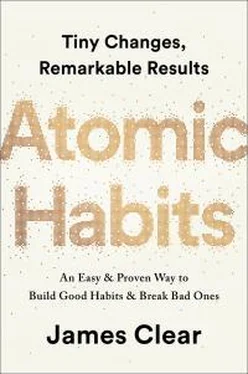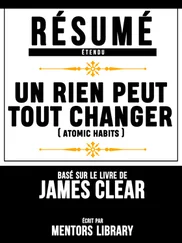Researchers have even found that voter turnout increases when people are forced to create implementation intentions by answering questions like: “What route are you taking to the polling station? At what time are you planning to go? What bus will get you there?” Other successful government programs have prompted citizens to make a clear plan to send taxes in on time or provided directions on when and where to pay late traffic bills.
The punch line is clear: people who make a specific plan for when and where they will perform a new habit are more likely to follow through. Too many people try to change their habits without these basic details figured out. We tell ourselves, “I’m going to eat healthier” or “I’m going to write more,” but we never say when and where these habits are going to happen. We leave it up to chance and hope that we will “just remember to do it” or feel motivated at the right time. An implementation intention sweeps away foggy notions like “I want to work out more” or “I want to be more productive” or “I should vote” and transforms them into a concrete plan of action.
Many people think they lack motivation when what they really lack is clarity. It is not always obvious when and where to take action. Some people spend their entire lives waiting for the time to be right to make an improvement.
Once an implementation intention has been set, you don’t have to wait for inspiration to strike. Do I write a chapter today or not? Do I meditate this morning or at lunch? When the moment of action occurs, there is no need to make a decision. Simply follow your predetermined plan.
The simple way to apply this strategy to your habits is to fill out this sentence:
I will [BEHAVIOR] at [TIME] in [LOCATION].
Meditation. I will meditate for one minute at 7 a.m. in my kitchen.
Studying. I will study Spanish for twenty minutes at 6 p.m. in my bedroom.
Exercise. I will exercise for one hour at 5 p.m. in my local gym.
Marriage. I will make my partner a cup of tea at 8 a.m. in the kitchen.
If you aren’t sure when to start your habit, try the first day of the week, month, or year. People are more likely to take action at those times because hope is usually higher. If we have hope, we have a reason to take action. A fresh start feels motivating.
There is another benefit to implementation intentions. Being specific about what you want and how you will achieve it helps you say no to things that derail progress, distract your attention, and pull you off course. We often say yes to little requests because we are not clear enough about what we need to be doing instead. When your dreams are vague, it’s easy to rationalize little exceptions all day long and never get around to the specific things you need to do to succeed.
Give your habits a time and a space to live in the world. The goal is to make the time and location so obvious that, with enough repetition, you get an urge to do the right thing at the right time, even if you can’t say why. As the writer Jason Zweig noted, “Obviously you’re never going to just work out without conscious thought. But like a dog salivating at a bell, maybe you start to get antsy around the time of day you normally work out.”
There are many ways to use implementation intentions in your life and work. My favorite approach is one I learned from Stanford professor BJ Fogg and it is a strategy I refer to as habit stacking .
HABIT STACKING: A SIMPLE PLAN TO OVERHAUL YOUR HABITS
The French philosopher Denis Diderot lived nearly his entire life in poverty, but that all changed one day in 1765.
Diderot’s daughter was about to be married and he could not afford to pay for the wedding. Despite his lack of wealth, Diderot was well known for his role as the co-founder and writer of Encyclopédie , one of the most comprehensive encyclopedias of the time. When Catherine the Great, the Empress of Russia, heard of Diderot’s financial troubles, her heart went out to him. She was a book lover and greatly enjoyed his encyclopedia. She offered to buy Diderot’s personal library for £1,000—more than $150,000 today.* Suddenly, Diderot had money to spare. With his new wealth, he not only paid for the wedding but also acquired a scarlet robe for himself.
Diderot’s scarlet robe was beautiful. So beautiful, in fact, that he immediately noticed how out of place it seemed when surrounded by his more common possessions. He wrote that there was “no more coordination, no more unity, no more beauty” between his elegant robe and the rest of his stuff.
Diderot soon felt the urge to upgrade his possessions. He replaced his rug with one from Damascus. He decorated his home with expensive sculptures. He bought a mirror to place above the mantel, and a better kitchen table. He tossed aside his old straw chair for a leather one. Like falling dominoes, one purchase led to the next.
Diderot’s behavior is not uncommon. In fact, the tendency for one purchase to lead to another one has a name: the Diderot Effect. The Diderot Effect states that obtaining a new possession often creates a spiral of consumption that leads to additional purchases.
You can spot this pattern everywhere. You buy a dress and have to get new shoes and earrings to match. You buy a couch and suddenly question the layout of your entire living room. You buy a toy for your child and soon find yourself purchasing all of the accessories that go with it. It’s a chain reaction of purchases.
Many human behaviors follow this cycle. You often decide what to do next based on what you have just finished doing. Going to the bathroom leads to washing and drying your hands, which reminds you that you need to put the dirty towels in the laundry, so you add laundry detergent to the shopping list, and so on. No behavior happens in isolation. Each action becomes a cue that triggers the next behavior.
Why is this important?
When it comes to building new habits, you can use the connectedness of behavior to your advantage. One of the best ways to build a new habit is to identify a current habit you already do each day and then stack your new behavior on top. This is called habit stacking .
Habit stacking is a special form of an implementation intention. Rather than pairing your new habit with a particular time and location, you pair it with a current habit. This method, which was created by BJ Fogg as part of his Tiny Habits program, can be used to design an obvious cue for nearly any habit.*
The habit stacking formula is:
“After [CURRENT HABIT], I will [NEW HABIT].”
For example:
Meditation. After I pour my cup of coffee each morning, I will meditate for one minute.
Exercise. After I take off my work shoes, I will immediately change into my workout clothes.
Gratitude. After I sit down to dinner, I will say one thing I’m grateful for that happened today.
Marriage. After I get into bed at night, I will give my partner a kiss.
Safety. After I put on my running shoes, I will text a friend or family member where I am running and how long it will take.
The key is to tie your desired behavior into something you already do each day. Once you have mastered this basic structure, you can begin to create larger stacks by chaining small habits together. This allows you to take advantage of the natural momentum that comes from one behavior leading into the next—a positive version of the Diderot Effect.
HABIT STACKING
FIGURE 7: Habit stacking increases the likelihood that you’ll stick with a habit by stacking your new behavior on top of an old one. This process can be repeated to chain numerous habits together, each one acting as the cue for the next.
Your morning routine habit stack might look like this:
Читать дальше




![Джеймс Клир - Атомные привычки [Как приобрести хорошие привычки и избавиться от плохих]](/books/403243/dzhejms-klir-atomnye-privychki-kak-priobresti-horosh-thumb.webp)



